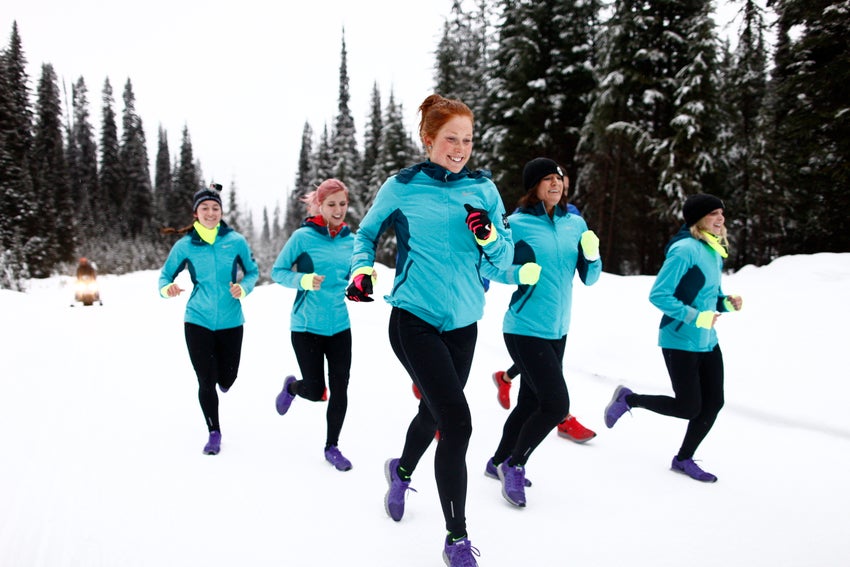Paula Findlay’s Winter Running Tips

Findlay enjoys a cozy cold weather run at the Nike sponsored Project North running event in Canada’s Bugaboo Mountains.
A native of Edmonton, Canada, Olympian Paula Findlay knows a thing or two about cold winter weather. Rather than retreat indoors, Findlay prefers to embrace the freeze and run outside year-round. “I do really love winter,” she says. “I kind of thrive in cold weather more than hot weather. Going out for a run in 35 degrees Celsius just kills me, but going in minus 10 or minus 15 actually makes me feel super good!”
Hailing from a family of skiers, Findlay is no stranger to time in the snow, and looks forward to spending each holiday season in the mountain retreat of Canmore where she regularly skis and runs, regardless of the temperature. “Last Christmas I didn’t even look at the temperature, I just went out for a run on Christmas day because I always do. I went out at about 11 o’ clock, so I just put on a running jacket and tights and a hat–and I absolutely froze! It was the coldest I’ve ever been. But I kept running for an hour, just thinking I was being a wimp and I would warm up. I came in and looked at my phone and it was minus 32 Celsius outside! That was maybe a little too cold and I wasn’t really dressed for it, but as long as you do dress for it you really can run in just about any weather.”
Granted, Findlay is a special breed of tough. “Nothing keeps people from Edmonton indoors,” says Findlay. “People go running in any weather. They go out and drive even when the roads are totally treacherous. It definitely makes you tough, being from Edmonton! You just have to kind of embrace winter if you live in Canada. If you sit inside and hate it, you’re going to be miserable. But f you embrace the fact that you can still exercise outside–ski and run with the right clothes or get a fat bike and ride–then it’s really fun. I’ve just chosen to embrace it!”
Findlay shares her tips for enjoying the great outdoors, even in winter’s deepest chill.
RELATED: Does Winter Running Burn More Calories?
Layer Up & Keep It Core
Findlay opts for multiple layers when heading outside. “You just have to dress properly to stay warm and comfortable. You can only take off so many clothes in hot weather, but you can layer up as much as you need for the cold,” she says. “Over this Christmas, it was minus 25 Celsius one day and I hiked up a mountain with my friend and we were totally comfortable the whole time because we were wearing the right clothes.” Keeping a warm neck and core is top priority for Findlay. “One of the most important things is having a neck gaiter. Air goes down your shirt if you don’t have one, and that’s what can make you really cold,” she says. “But with a gaiter you can pull it up over your face if it’s windy and icy, or you can just keep it down around your neck and it stops the wind from reaching your core. I find that as long as I have a good core layer on, I’m usually pretty comfortable. If my core is warm it keeps everything else warm–it doesn’t matter as much what I wear on my legs. And I almost always wear a hat and definitely gloves.”
Footwear also figures into Findlay’s plan for winter warmth. “The right footwear is important. Generally, if it’s just snowy and not icy, I’ll wear regular running shoes, but I wear the winterized version of all my running shoes. They’re waterproof, which is really important because they keep my feet dry and warm. I also usually wear wool socks when I run in the cold,” says Findlay.
RELATED: Triathlete’s Winter Training Clothing Roundup
Baby Steps For A Strong Base
“Because the slippery ground can be a little bit dangerous, it forces you to run really slowly. I think that’s actually really good for this time of year. It forces you to hold yourself back–to do base miles and do them at the right speed. It can be easy to get carried away and want to rush back into fitness at the start of the season, but when you’re running on snow it’s impossible to do that,” says Findlay. “There is a bit of a risk of slipping and injuring yourself, but you just have to watch your footing and be careful. You have to go slower, take smaller steps and not push off as hard. I really enjoy it. And because of the base training I’ve done this winter, I feel stronger. I’ve been able to build up my running to 90 minutes no problem, when I used to never be able to run 90 minutes. It was too long for me.”
RELATED: Ask a Trainer: How Do I Run in Winter Without Getting Injured?
Chill In The Chill
Findlay advocates a more relaxed approach to winter runs, in keeping with the need to proceed with a certain degree of caution. “In the winter I never wear my GPS. I try not to worry about how far or what pace I’m going–that’s a sure way to slip and fall. Rather, just get out the door!”
RELATED: Paula Findlay Shares Her Path from Struggle to Success